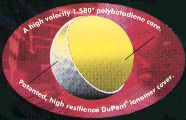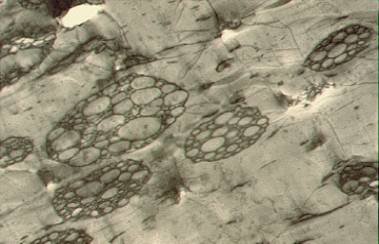The game of golf! I hear what you non-players say its just hitting a ball
around a field into a hole and you're right but the equipment used is big
business! A golf ball can be made to be a complex arrangement of polymer and
ionmer layers or simply as in the old days a leather feather ball.
There are a vast number of balls on the market nowadays consisting of many
desired setups for varied methods of play ie. there are two-piece balls,
three-piece balls, balata and Surlyn balls, wound balls, liquid-center balls,
titanium-center balls, "senior" balls, "ladies" balls, balls
that offer "extra distance" or "extra spin". The player
themselves can only really determine the correct ball for them by trial and
error (Hmm very technical!).
 The
core composition of the golf ball is what determines the shapes of shot. This
consists generally of a cover, outer wound and centre. Changes in the core composition
affect spin rate (control), initial velocity (distance) and compression (feel)
and as a result the player is restricted as to what type of shot he can play
with the ball he is playing (or Her).
The
core composition of the golf ball is what determines the shapes of shot. This
consists generally of a cover, outer wound and centre. Changes in the core composition
affect spin rate (control), initial velocity (distance) and compression (feel)
and as a result the player is restricted as to what type of shot he can play
with the ball he is playing (or Her).
Wound , Two and Three piece balls
The core composition, either wound or solid, offer significant differences in
control and feel. Wound balls have three parts consisting of center, winding and
cover which offers more spin and control but a loss of distance.
Solid balls are comprised of two parts, a solid core and cover. Solid, or
two-piece balls, offer more distance but less spin and control. In general, the
core is generally a compound of natural and synthetic rubbers.
Surlyn
The structure of this material is quite secretive and has been patented due
to its cut resistance and spin control. The cover is known as the polymer that
keeps the smiles off golf balls ie. the cutting of the cover is relatively non
existent.
Balata
This was once manufactured from the dried sap of the now extinct sapodilla
tree in South America. Due to its extinction it is now made of a blend of soft,
thermoplastic, elastomer-like compounds. An example of a present day balata is
from Fila in which the formulated golf ball features a magnesium balata cover
that allegedly delivers feel and control, with high impact and cut
resistance.
Titanium Core
The large core is a blend of synthetic and
natural rubber bonded with pure Titanium. This combination ensures perfect
bonding, so energy is transferred from the clubface to the intended direction.
The advantage of this ball is that it achieves a greater distance and accuracy
for beginners than say the balata or wound balls.
Polybutadiene
This Material is the second largest
volume synthetic rubber produced, next to styrene-butadiene rubber.
Approximately 20,000 metric tons worldwide of polybutadiene is used each
year in golf ball cores due to its outstanding resiliency. This application is
growing as wound ball technology is fading into the more diverse two-piece,
solid core construction.

So I hear you say why bother with all this! I say I don't know, unless you
can hit a ball well every time like the pros the choice of ball makes very
little difference at all, ahh well I can dream!
 The
core composition of the golf ball is what determines the shapes of shot. This
consists generally of a cover, outer wound and centre. Changes in the core composition
affect spin rate (control), initial velocity (distance) and compression (feel)
and as a result the player is restricted as to what type of shot he can play
with the ball he is playing (or Her).
The
core composition of the golf ball is what determines the shapes of shot. This
consists generally of a cover, outer wound and centre. Changes in the core composition
affect spin rate (control), initial velocity (distance) and compression (feel)
and as a result the player is restricted as to what type of shot he can play
with the ball he is playing (or Her).
